U.S. Department of Transportation
Federal Highway Administration
1200 New Jersey Avenue, SE
Washington, DC 20590
202-366-4000
![]()

Quality data are the foundation for making sound decisions regarding the design, operation, and safety of roadways. Safety programs such as the Federal Highway Administration's (FHWA's) Highway Safety Improvement Program (HSIP) and more advanced analysis tools such as the Highway Safety Manual (HSM) (1) and Safety Analyst (2) rely on crash, roadway, and traffic data to conduct effective analyses for problem identification and evaluation. Robust data can help agencies improve safety by making more effective and efficient use of safety funds, which will help save lives and reduce serious injuries.
National leadership recognizes the importance of a robust data system for safety. The current transportation legislation, Moving Ahead for Progress in the 21st Century (MAP-21), requires States to have a safety data system in place to perform analyses supporting the strategic and performance-based goals in the Strategic Highway Safety Plan (SHSP) and HSIP [23 U.S.C. 148 (c) (2)] (3). MAP -21 defines safety data as crash, roadway, and traffic data on a public road [23 U.S.C. 148 (a) (9)] (3). The Model Inventoryof Roadway Elements (MIRE) provides guidance to transportation agencies on collecting safety-related roadway and traffic data (4).
The FHWA developed MIRE as a recommended listing and data dictionary of roadway and traffic data elements critical to supporting highway safety management programs and tools. MIRE consists of 202 roadway and traffic data elements grouped under three major categories: 1) roadway segments, 2) roadway alignments, and 3) roadway junctions. The next step in the effort to expand the use of MIRE involved examining the feasibility of collecting and integrating these data elements into a management information system (MIS). It is envisioned that States would ultimately integrate roadway data with crash data and other safety-related data for a complete safety information system.
The Model Inventory of Roadway Elements (MIRE) is a recommended listing and data dictionary of roadway and traffic data elements to support safety.
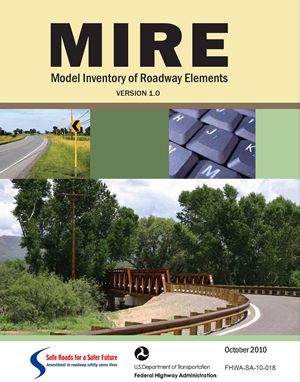
The Model Inventory of Roadway Elements (MIRE) is a recommended listing and data dictionary of roadway and traffic data elements to support safety.
The objective of the MIRE MIS project was to test the feasibility of converting the MIRE listing into an MIS. The project team conducted this effort through the exploration, development, and documentation of:
MIRE data quality and MIS performance. The project team undertook several tasks to achieve these objectives. This report provides an overview of these tasks, highlighting the results and lessons learned that are most applicable to agencies wanting to improve their roadway and traffic data to support their safety programs.
The project team began by assessing States' and local agencies' current data systems, and problem identification and prioritization processes on both State-owned and locally- owned roads. Establishing this information as a baseline provided an understanding of the challenges States face in integrating various types of data (crash, roadway, traffic data, etc.). The project team gathered information during site visits with several State and local departments of transportation (DOTs), and included the status of the agencies' data (crash roadway, and traffic); how agencies utilize those data for their safety programs (network screening, project prioritization, etc.); the structure of their database files; and any innovative data collection methodologies they employ.
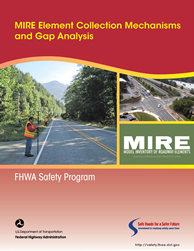
In addition to obtaining such information on site visits, the project team conducted additional research to further explore MIRE data collection methodologies. The MIRE Element Collection Mechanisms and Gap Analysis report provides an assessment of State highway agencies' roadway inventory data collection practices, documentation of current and emerging MIRE element data collection mechanisms, identification of gaps in current practices, and recommendations for filling those gaps to support the MIRE MIS effort (5).
The MIRE Element Collection Mechanisms and Gap Analysis report provides methodologies and recommendations that can help States determine how best to collect additional or improved roadway data to implement a roadway inventory system, such as a safety MIS, to help support their safety programs through data-driven decision-making.
Collecting additional roadway safety data can be a large undertaking. Based on the results of this effort, the research team developed several recommendations to help States implement a MIRE MIS. States should consider using other available information systems as sources of data. Integrating the available data systems and data needs within the agency will help minimize the data collection and processing efforts of various internal departments. States should also standardize data collection methods to ensure quality and simplify transfer between information systems. While multiple technologies are available to assist States in data collection, public and private sectors should explore the development of automated techniques for extracting inventory feature data from advanced collection techniques into a usable database format. These steps can help States develop the MIRE into a safety MIS to help support their safety programs through data-driven decision-making.

The project team further explored mechanisms for collecting MIRE data through three major tasks: 1) a pilot data collection effort where MIRE data were collected in two States; 2) a white paper that explores the use of a "collective information" approach for obtaining transportation safety data; and, 3) development of a MIRE data collection guidebook. The following sections provide more details on each of these efforts.
The project team conducted a MIRE pilot data collection effort to test the feasibility of collecting MIRE data for two lead agencies, New Hampshire and Washington State. Both pilot projects relied heavily on the use of Geographic Information Systems (GIS) to collect, analyze, and store MIRE data. Many transportation agencies already collect and store roadway attributes within a GIS. Often the data structure is designed for a specific purpose, which may make it difficult for all departments within an agency to use the data.
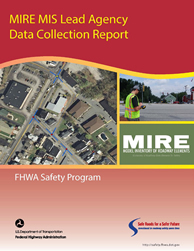
The pilot projects utilized existing roadway data from multiple sources, supplemented by manual data collection efforts to collect additional MIRE data for use in building a statewide intersection inventory in both states. The MIRE MIS Lead Agency Data Collection Report documents the methods used to examine existing roadway data within an agency, to collect additional MIRE data, and to develop an intersection inventory, as well as the data collection tools used, challenges faced, and lessons learned (6).
The results of this effort were:
The lessons learned from this effort were:
One of the biggest challenges in using an MIS for highway safety is the lack of roadway inventory data. This is particularly true for local roads. Most transportation agencies are resource- constrained and do not have the staff or available funds to collect and maintain this information. However, a few transportation agencies have discovered that smart phones and other mobile devices may present an opportunity to cost-effectively collect data. The prevalence of these GPS-enabled mobile devices present a feasible option for acquiring roadway inventory data through crowdsourcing of collective information. Crowdsourcing is the process of assembling data or collecting information on a subject using a large, disperse, and potentially uncontrolled group of people.
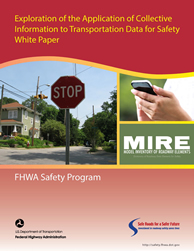
The Exploration of the Application of Collective Information to Transportation Data for Safety White Paper explores the application of collective information in transportation data, particularly in the collection and management of MIRE data (7). Transportation agencies could use any number of individuals to collect this information, such as contractors, maintenance crews, volunteer organizations, and the general public.
The collective information white paper is a starting point for discussions on the application and feasibility of using collective information for transportation safety data. It also identifies potential next steps and future applications of this concept.
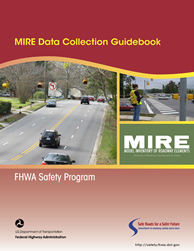
The results of the effort to develop a MIRE MIS structure can help other agencies interested in developing a MIS for their safety data using readily available tools and resources.
The project team first developed a conceptual model of a potential MIRE MIS, and then expanded on that by developing a logical database model based on the MIRE Version 1.0 specification. The project team then expanded the structure to incorporate supplemental datasets mentioned in MIRE Version 1.0 that are not part of the 202 MIRE element listing. Data provided by one of the Lead Agency States, New Hampshire, was then imported into the system along with data from the MIRE Pilot Data Collection effort to create a working MIS.
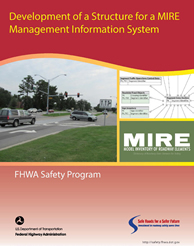
The development of the prototype helped identify several key challenges that a State will need to address in the implementation of a safety MIS. The project team also developed several implementation scenarios to help agencies that are considering implementation of a safety MIS.
The results of this effort were:
The lessons learned from this effort were:
The Development of a Structure for a MIRE Management Information System report documents the effort, including details on the structure, obstacles, and lessons learned (9).
Performance measures are tools for measuring data quality and establishing goals for data improvement. The primary quality characteristics for safety data include:
|
 |
The Performance Measures for Roadway Inventory Data report documents the result of an effort to build upon a previous publication by the National Highway Traffic Safety Administration (NHTSA), the Model Performance Measures for State Traffic Records Systems (10, 11) focusing on expanding the measures for roadway data. The Performance Measures for Roadway Inventory Data report also provides suggestions for data-related business practices that can lead to improvements in roadway data.
The results of the FHWA performance measure effort provide data managers and collectors with refined techniques for assessing and improving the quality of the roadway and traffic data inventory data they collect and maintain.
Integrating quality roadway and traffic data with crash data can help agencies make better decisions and more effective use of limited funds to improve safety, and meet Federal Legislative requirements. The MIRE MIS effort provides lessons on how to collect, integrate, manage, and measure data for improved safety decision- making.
Better data help lead to better decisions, which ultimately can save lives!
The MIRE MIS effort yielded several products and reports that will be valuable in helping practitioners improve their roadway data to support a data-driven safety program. These include:
Data Collection:
Structure of the MIS:
Performance Measures:
These documents can be found at http://safety.fhwa.dot.gov/rsdp.
This project was performed by Nancy X. Lefler, Hugh McGee, Rebecca Fiedler, Kimberly Eccles, Dale Abbott, and Michael Altobello from Vanasse Hangen Brustlin, Inc.; Jag Malella from Applied Research Associates; and Barbara Hilger Delucia from Data Nexus Inc.
Visit http://safety.fhwa.dot.gov/rsdp/
| Robert Pollack Federal Highway Administration Office of Safety Programs robert.pollack@dot.gov |
Carol Tan, PhD Federal Highway Administration Office of Safety Research and Development carol.tan@dot.gov |
FHWA-SA-13-020
